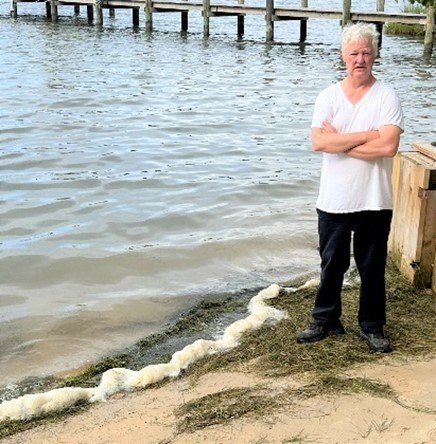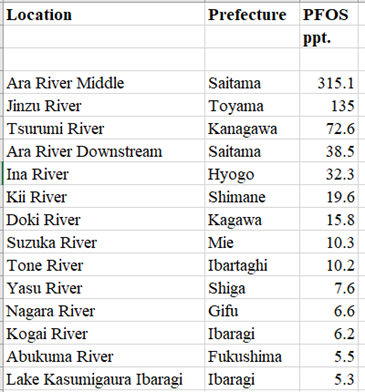Survey of PFAS in Japan (part 1 of 4)
The drinking water and the surface water
are contaminated with PFAS
By Pat Elder
August 27, 2023
A model of Perfluoro octane sulfonic acid (PFOS) is superimposed over a map of Japan. PFOS has 29 atoms – 8 Carbon, 17 Hydrogen Fluoride, 3 Oxygen, and 1 Sulfur atom. This chemistry is re-shaping the world.
Thanks to the heroic reporting by Jon Mitchell in 2016 we know that recurring releases of aqueous film-forming foam, (AFFF) containing pre-and poly fluoroalkyl substances known as PFAS from U.S. military installations have been largely responsible for the contamination of drinking water and the environment in Okinawa. This was a wakeup call to all of Japan.
Although it has been seven years since Mitchell’s groundbreaking work, the Japanese public is slow to accept the notion that municipal drinking water comprises a small part of the PFAS we consume. Contaminated food, especially the fish we eat, poses an even greater threat to our health than the drinking water.
The drinking water is dangerous. A survey concluded a few months ago by Kyoto University Associate Professor Kouji Harada and the Japanese newspaper Tokyo Shimbun examined two dozen drinking water locations in Kanagawa prefecture, just west of Tokyo, and found eight locations with concentrations of two PFAS compounds – PFOS and PFOA exceeding Japan’s non-enforceable target of 50 parts per trillion (ppt) in tap water, groundwater, and surface water.
The survey examined 24 locations in Sagamihara and one in Machida.
The scientists tested rivers, springs, and wells. Eight locations measured between 55 and 301 parts per trillion, Harada said. Many of the remaining locations measured between 30 to 40 parts per trillion. The U.S. EPA has instituted interim levels for PFOS (.02 ppt) and PFOA (.004 ppt) in drinking water. The the levels of the carcinogens in Tokyo’s water may be up to 75,000 times over the unenforced American threshold.
The Japanese seem to be convinced that the primary route for human exposure to PFAS is from the drinking water, while the relatively weak efforts by the national and prefectural governments have focused on reducing these levels.
Japan has barely started taking the threat of PFAS seriously. The country has no enforceable regulatory standards for PFAS in any media. Drinking water throughout much of Japan may be hazardous to health, however, we must fix our attention on the contamination of surface waters and aquatic life to address an even greater threat to public health.
Surface Water
The contamination of surface waters like streams and rivers and bays in Japan pose the greatest threat to public health while nearly all public attention is fixed on PFAS in drinking water. Here’s an abbreviated list of specific instances of the U.S. military’s contamination of surface waters in Japan. The levels herein will make more sense when we examine bioaccumulation of these substances in the aquatic life we consume.
Jon Mitchell reported in 2020 that U.S. Air Force testing of 11 fire suppression systems in 2016 showed the foam contained levels of PFOA reaching 99 million ppt and PFOS of up to 9.5 billion ppt.
In 2022 at the Navy’s Yokosuka base on Tokyo Bay, the Navy reported PFOA in concentrations of 12,900 ppt in wastewater.
In 2020 a river near Atsugi Naval Air Facility was contaminated with PFOA/PFOS levels at 249 ppt. The base has reported numerous releases of AFFF.
In 2022 a frozen pipe was blamed for the release of PFAS in an airport hangar at Misawa Air Base in northeastern Japan. The pipe cracked and released water through a fire suppression system. Samples of the wastewater treatment plant showed 2,079 ppt of PFOA/PFOS where the liquid effluent empties into the environment.
Between 1997 and 2016, there were at least 12 spills of firefighting foams at MCAS Iwakuni.
Stars and Stripes reported in July, 2023 that a fire-suppression system inside a hangar at the Naval Air Facility Atsugi accidentally released about 1,850 gallons of fire-extinguishing foam on September 22, 2022.
In 2005 Akio Koizumi, professor at Kyoto University, reported that the Tama River Joryu Sewage Plant discharged 440 ppt of PFOS in the Tama River near Yokota Air Base. They could not specify the origin because waters from more than 40 sewer systems drained into the plant.
Nishino T, et. al (2014) reported 150 ppt of PFOS from the Tama River.
Selected instances of surface water contamination
caused by the U.S. military in Okinawa
Kadena Air Base
In June 2013, an overflowing manhole leaked 208,000 liters of sewage believed to contain PFAS into the Hija River near Kadena Air Base
According to FOIA reports obtained by Jon Mitchell, between 2001 and 2015, Kadena Air Base released at least 23,000 liters of various firefighting foams. In 2019 a pond about 200 meters from the Kadena town hall contained 90,000 ppt
Yara Ubuga, a natural spring approximately 2,000 feet from the northern edge of Kadena Air Base in Okinawa, contained 1,800 ppt of PFOS/PFOA in July, 2023.
In June 2020, test results announced by the Ministry of the Environment revealed that the Dakujaku River by Kadena Air Base in Okinawa was contaminated with PFOS at 1,462 ppt
The Dakujaku River near Kadena Air Base had 1,379 ppt of PFOA/PFOS.
U.S. Marine Corps Air Station Futenma
At MCAS Futenma, between 2005 and 2009, there were at least three spills of foam involving a total of 2,700 liters of AFFF.
On August 26, 2021, the U.S. Marine Corps Air Station Futenma, located in Ginowan City, Okinawa, released approximately 64,000 liters of wastewater with PFAS into the municipal sewer system. The Okinawan authorities took water samples from a manhole outside the base shortly after. They found a combined concentration of PFOS and PFOA measuring 670 ppt.
At MCAS Futenma, tests conducted in February 2016 at its firefighting training pit revealed PFOA contamination of 1,800 ppt and PFOS contamination of 27,000 ppt in groundwater that drains into surface water.
On 10 April, 2020 a fire suppression system inside a hangar aboard MCAS Futenma activated after Marines lit a barbecue. Later, the USMC estimated that the leak had involved 232,000 liters of AFFF and water. The bubbles coated the town. Colonel David Steele, MCAS Futenma commanding officer, assured locals that the foam would subside if it rained.
Tests revealed combined PFOA/PFOS levels in the Uchidomari River near MCAS Futenma of 255 ppt and 36 ppt in the sea; other PFAS, including PFHxS and PFHxA, were also detected.
At Camp Hansen, in October 2019, prefectural officials detected PFOS levels of 300 ppt in water draining from the base.
Foam in Naha. – Ryukyu Shimpo
On February 26, 2021, firefighting foam poured from the Japan Air Self-Defense Force (JASDF) Naha Base in Okinawa. A base spokesperson said that the foam posed little or no toxicity or harm.
The Okinawans have learned a great deal in the last seven years, and they are particularly sensitive to the damage caused by PFOS to surface waters and aquatic life. A Ryukyu Shimpo reporter gathered foam near the site of the incident and sent the sample to be analyzed by Professor Harada. Harada’s results showed that high concentrations of PFOS and other PFAS compounds were detected in the foam. Ryukyu Shimpo reported these concentrations:
PFOS 3,010 ppt
PFOA 3,380
PFHxS 3,040
Total 9,430 ppt
(In July 2023 I collected the foam shown here on my beach on the St. Mary’s River in Southern Maryland, 150 kilometers south of Washington. I found 3,660.9 ppt of PFOS with 6,449.2 ppt of total PFAS in the foam on the beach. I am shown here 550 meters across the water from the Webster Field Annex of the Patuxent River Naval Air Station. The oysters, crabs, and fish are all contaminated.)
More than twenty years ago Professors Koizumi, Harada and others surveyed concentrations of PFOS in surface waters throughout Japan. This chart shows levels of PFAS above 5 ppt. The contamination shown here has likely been caused by various industrial polluters.
The samples taken in 2002 showed levels of seawater generally under 5 parts per trillion except for Koshien Bay, Hyogo - 25.2 ppt and Nagoya Bay, Aichi - 20.6 ppt. Waters with 1 part per trillion of PFOS may present a danger to public health.
Jon Mitchell explains the perils of PFAS - photo Tokyo Shinbun
The Japanese nation owes a debt of gratitude to Jon Mitchell, the great British journalist who is responsible for drawing attention to the link between US military activities and the contamination of the nation’s drinking water. Mitchell frequently filed and received Freedom of Information Act (FOIA) requests for internal U.S. military documents.
Thanks to Mitchell, we know a significant release of aqueous film-forming foam (AFFF) concentrate occurred on November 29, 2012, at the Yokota Fire Station on Yokota Air Base. The foam we recognize on our beaches is made up of 97 parts water and 3 parts AFFF concentrate. The Yokota Air Base leak resulted in the release of more than 3,000 liters of concentrate. The region will be poisoned beyond our lifetimes.
An environmental review prepared by the US military in 2015 noted that material draining from from the base "eventually ends up in a layer of groundwater about 75 meters deep." In fiscal 2018, the Tokyo metropolitan government detected a concentration of 1,340 ppt of PFAS in a well in Tachikawa City about 1 km southeast of the base. This was the highest level in Tokyo.
<end part 1>
Financial support from the Downs Law Group makes it possible for us to test water for PFAS. The firm is working to provide legal representation to individuals with a high likelihood of exposure to PFAS and other contaminants.
The Downs Law Group employs attorneys accredited by the Department of Veterans Affairs to assist those who have served in obtaining VA Compensation and Pension Benefits they are rightly owed.
If you spent time in the military and you think you may be sick as a result of your service, think about joining this group to learn from others with similar issues. Are you interested in joining a multi-base class action lawsuit pertaining to illnesses stemming from various kinds of environmental contamination? Join the Veterans & Civilians Clean Water Alliance Facebook group. (2.4 K members and growing rapidly.)







